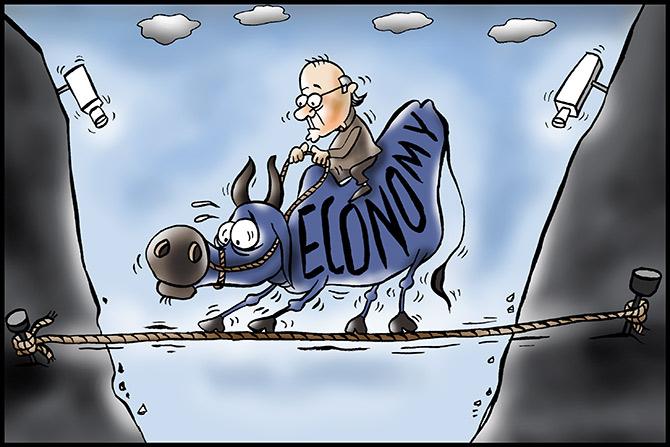However, economic growth in five years of the UPA and NDA cannot be compared because of the now complex back series data, reports Indivjal Dhasmana.
Illustration: Uttam Ghosh/Rediff.com

Advance estimates say growth in the last year of this term of the Narendra Modi government will be higher than in 2013-14, the last year of the United Progressive Alliance (UPA) regime, though the potential for higher growth was greater.
Growth was 6.4 per cent in 2013-14.
However, the last financial year of the UPA government saw an improvement over 5.5 per cent in 2012-13, though both the years were criticised as those of policy paralysis.
Advance estimates say growth will be 7.2 per cent in 2018-19, the NDA's last financial year.
It is certainly an improvement, though growth had reached 8.1 per cent in 2015-16 and hence could have expanded at a much higher pace than what was estimated officially for FY19.
Economic growth in five years of the UPA and NDA cannot be compared because of the now complex back series data.
The reasons for slowing growth between 2015-16 and 2018-19 cannot entirely be found in the Budgets but outside.
In fact, the two most prominent pull down factors -- demonetisation and the initial jitters of the goods and services tax (GST) -- lie outside the scope of the Budget.
Nonetheless, Budget provisions did make an impact on economic expansion, besides the twin factors cited above.
As could be seen from the charts, the lowest growth was witnessed in 2017-18 due to the lingering effects of demonetisation and initial jitters and complexities of the GST.
However, the government capital expenditure, which is spent on asset creation, also contracted for the first time in the Modi government in 2017-18.
The expenditure was crucial since the private investments remained subdued due to various reasons including bank bad debts, over-leveraged corporate debts, etc.
That year also saw gross fixed capital formation growth dipping to 7.6 per cent from 10.1 per cent in the previous year.

However, nowadays states, put together, account for much higher capital expenditure, almost twice than the Centre.
The cut in capex by the Centre may have also been warranted as the Centre was not able to cut revenue expenditure.
It grew by 15 per cent in 2017-18 against 9.9 per cent in the previous year.
Though for the fiscal deficit, cutting revenue expenditure is considered more qualitative, high revenue expenditure did give boost to consumption expenditure that denoted demand in the economy.
Even then, growth in private final consumption expenditure in the economy declined to 6.6 per cent in FY18 compared to 7.3 per cent in the previous year.
Ranen Banerjee, leader public finance and economics, PwC India, said the Centre's capex and revenue expenditure do affect the economic growth.
The capex has a multiplier effect as well through increase in employment and hence rise in consumption. But, that comes out with some lag, he said.
D K Srivastava, chief policy advisor in EY India, said though revenue expenditure did give a boost to economic growth, it is short-term.
Main push factor comes from capex which remains quite low in India, including in the Modi era.
The cut in capex was also warranted in FY18 as the GST collections did not come for one month due to the method of collections.
While GST remained operational for nine months that year, the collections came for only eight months since those of March were paid in April.
Though it is difficult to compare GST collections in FY18 with those in the previous year since there was no GST that time, one can compare overall tax revenues collected by the Centre.
These fell short of Rs 30,776 crore, at Rs 901664 crore (pre-devolution to states).
The blame cannot be laid on GST alone, as corporation tax target fell short of Rs 32,310 crore, but the issue was that it could not be offset by GST.
This year as well, as the government faces shortfall in GST collections, with one estimates putting it at Rs 58,000 crore just on the Centre's account, it will have to struggle for cutting expenditure.
Besides, non-tax revenues fell short of Rs 52,783 crore.
In these situations, the axe generally falls on capex, said Srivastava.
The Centre's capex recorded a contraction of 33 per cent in November year-on-year. Growth was muted at 4 per cent in the first eight months of the current financial year.
The impact of this was seen on economic growth as well.
The advance estimates growth number for the current financial year is lower than the finance ministry's projection of 7.5 per cent and also that of conservative Reserve Bank of India's at 7.4 per cent.











